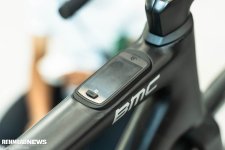On the power side, I bet 40nm is plenty of torque for a bike that light-- at first I couldn't believe the listed potential range, but when I thought about it, it seemed less crazy. I mean, I guess... if a 47 pound 250W 40nm eMTB can do about 45 miles with 4,500 feet of vertical, it makes sense intuitively that a 22 pound bike with a 200W 40nm motor could do 62 miles with 6,500 feet of vertical, though I think the gearing and
grade of the vertical would be significant variables (as well as rider fitness!) (I am noticing that the Grizl's range is significantly better for a given amount of vertical if the grade is more gentle.)
The concept of a 22-pound electric road bike is fascinating and vaguely terrifying. I don't know if I'd like being on even an acoustic bike that light except someplace where there are no cars. I know professional riders and racers must do this all the time, it just scares the hell out of me.
My Salsa Vaya all steel road bike is 27 lbs ffs.
I think my 1974 531 Reynolds Raleigh Competition is over 23 pounds, might be 24, and I only had it up to about 38 or 39 MPH once or twice when I was young and crazy, 34 or 35 were more normal speeds. Even then, I was rarely going over 30 MPH when there was any traffic, usually only in the park with other cyclists, which was scary enough.
I have not had the Grizl:ON over 37 MPH on descents because-- even with the dampening from the front shock & the seatpost and the CF-- I still don't feel confident (yet) going that fast on a 36 pound bike, though I'm comfortable taking the 46.5 pound eMTB up to 43 MPH. Descending on the Hollywood side of the Cahuenga pass, I feel this weird safety-related cognitive dissonance because on the one hand, I want to go faster so the difference in speed between myself and the cars is decreased, but slower because I don't know how the bike will react if there's a crack or pothole that I don't see in time, so I held it to around 34.
I'm sure there are roads where you can ride a road bike without encountering this problem, just very few that I am aware of near where I live!
I wonder what a 22 pound CF bike with no suspension and thin tires, with or without motor, feels like on bad pavement over 30 MPH. I'm sure it feels better than a steel or aluminum bike does, but still...

 granfondo-cycling.com
granfondo-cycling.com


